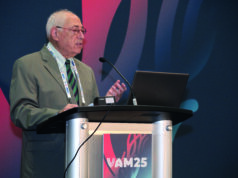Practical tips for protecting your vascular surgery patients and yourselves from radiation exposure will be featured as part of this morning’s session “Radiation Safety for the Vascular Surgeon.”
“Since endovascular procedures became an essential part of the vascular field about 25 years ago, minimally invasive, radiation-guided procedures have become more sophisticated, more involved and more frequent while requiring better resolution,” said session co-moderator Dr. Peter Schneider of Kaiser Permanente Medical Group in Honolulu. “All of this means more radiation for the patient and for the physician. Going forward, as our field continues to develop, the likelihood is high that these requirements will continue and will intensify and that the radiation risk to patients and providers will increase.
“Radiation is a necessary tool in our ability to help our patients,” Dr. Schneider added. “Yet radiation has negative effects, such as radiation-induced cancers and cataracts. We need to do everything we can to minimize those negative effects.”
A good 60%-70% of vascular procedures involve endovascular techniques that utilize radiation, said session co-moderator Dr. Amy Reed of Rush University Medical Center in Chicago. “Even though your patient may be exposed multiple times in the future through CAT scans or cardiac catheterizations, you as the surgeon are going to be doing this for decades – so the long-term exposure to radiation is a concern. Usually it goes hand in hand that if you’re protecting the patient, you’re protecting yourself as well.”
There are a number of measures vascular surgeons can take to minimize radiation exposure, the moderators said. “These include simple things like the use of radiation filters during imaging, decreasing frame rates to the lowest level that gives the imaging required, being careful about maintaining distance from the image intensifier during fluoroscopy and use of radiation shielding,” Dr. Schneider said.
Additional steps can include collimating or focusing the view and changing table positions, Dr. Reed noted. Good radiation safety techniques are especially important for residency program directors, she added: “Trainees stand closer to the radiation, so it’s important to have good technique. Just like universal precautions measures such as wearing gloves and washing hands, trainees are going to learn radiation safety by emulating you.”
During the session, six expert clinicians knowledgeable about the effects of radiation will share their wisdom. Dr. Christopher Carsten of Greenville Health System in South Carolina will cover what is known about the clinically allowable limits of radiation to the provider and to the patient; Dr. Sunita Srivastava of the Cleveland Clinic will provide a basic understanding of the mechanism of the biological effects of radiation; Dr. Melissa Kirkwood of the University of Texas Southwestern Medical Center in Dallas will offer practical tips to the vascular surgeon for decreasing radiation; Dr. Audra Duncan of the University of Western Ontario will discuss the need for diagnostic tests or radiation-guided procedures in patients who are pregnant; Dr. Mark Farber of the University of North Carolina will discuss new technologies in radiation monitoring; and Dr. Lois Killewich of the University of Texas Medical Branch in Galveston will cover governmental regulations associated with the clinical use of radiation.
“We’re really trying to increase the awareness of radiation safety,” Dr. Reed said. “It’s not to go over all of the things radiation can cause – we know that – but what’s on the horizon that might be helpful for you, and what tips you can take back for protection if you’re not currently using them.”
Friday Breakfast Session B4
6:30 A.M. – 8:00 A.M.
Potomac Ballroom C












